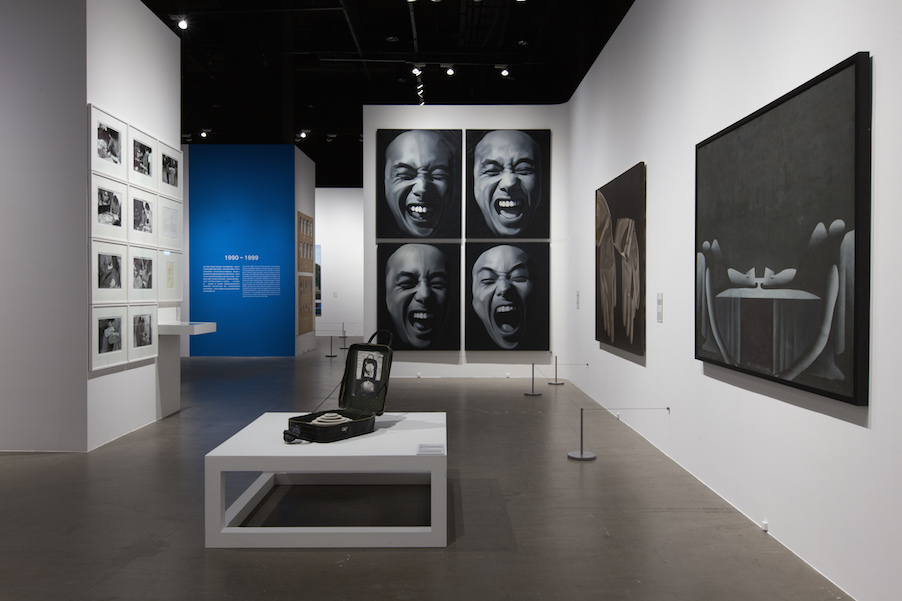On Tuesday, Hong Kong gets its first glimpse of the M+ Sigg collection, with an exhibition that has highlighted fears Beijing’s influence in the city is infecting the arts.
The M+ Sigg show features 80 works by famous Chinese names including Yue Minjun – known for his paintings of laughing faces – and surrealist Zhang Xiaogang.
It is billed as the first ever chronological exhibition on the emergence of Chinese contemporary art and gives a taste of a much wider collection that will eventually go on show at Hong Kong’s upcoming M+ art museum.
The massive 60,000-square-metre art venue, set to open in 2019, aims to rival Western contemporary heavyweights like London’s Tate Modern.
But the Hong Kong government-sponsored gallery has been criticised for failing to fully represent the local art scene and faces questions over its curatorial independence.
Some in the art community ask why it spent none of its HKD1.7 billion acquisition budget on creations that blossomed on Hong Kong’s streets during the pro-democracy Umbrella Movement of 2014.
Others question whether this week’s exhibition – on display at a smaller gallery, ArtisTree in Tai Koo Shing, as M+ awaits completion – has been pared back, pointing out its touring title, “Right is wrong”, has been dropped.
There have been queries over whether some more controversial works were excluded, and whether there was pressure to tone down the narrative of Beijing’s crushing of the 1989 Tiananmen Square protests.
M+ chief curator Doryun Chong defended the new exhibition, saying it is a “whole, full historical survey” of Chinese modern art – one that includes works by Beijing’s bete noire Ai Wei Wei.
He also insisted M+ has not been subject to political pressure, but admits the gallery takes a conservative approach to its collection and exhibitions.
“There might be certain institutions or curators who believe in the idea or the power of provocation, but I don’t believe in that,” Chong said.
‘The fear is here’
The questions swirling around M+ come as concern grows in Hong Kong over interference from Beijing in the city’s politics, education and the press.
Those fears have been exacerbated by the recent disappearances of five Hong Kong booksellers known for publishing titles critical of the Chinese government. Four are now under criminal investigation on the mainland.

Some connected to M+ say self-censorship is becoming a bigger problem in the city.
“In Hong Kong, we do feel like there is a big tightening of the public sphere over the past two or three years, whether it’s in publishing, in theatres, in exhibitions,” said Ada Wong, a local arts advocate and a member of the M+ museum committee.
“I think this administration in particular, they are very cautious as to what would upset Beijing,” adds Wong, referring to the CY Leung administration, seen as a staunch ally of China.
Wong said local artists have even begun to tone down their work for fear of upsetting the authorities.
“Self-censorship… it’s happening, it’s just still under the table,” she said. “The fear is here, and the tightening of control is definitely here.”
Artistic ambitions
The harbourfront M+ gallery venue in West Kowloon remains a sprawling construction site 20 years after it was first dreamt up.
Political interference has been blamed for delays that have eaten up the project’s entire HKD21.6 billion government grant and prompted senior figures including M+’s executive director Lars Nittve to step down.
West Kowloon Cultural District Authority (WKCDA) head Duncan Pescod admits the full complex – which will eventually also include a theatre and public parks – could take another 10 to 15 years to complete.
He told AFP the authority is considering working with several developers at the same time to speed things up.
But despite concerns, there is still hope that M+ will draw attention to the city’s undernourished creative industries.
“For a long time Hong Kong has perhaps not been the most hospitable city for emerging artists,” said Pearl Lam, who runs a prominent private gallery, pointing to the high cost of living and rental space.
“M+ will be exceptionally important for Hong Kong when it opens.”
Hong Kong is already a burgeoning art hub, the world’s fourth-largest art market and hosts major international show Art Basel.
There has been a recent explosion of galleries, with major Western brands like White Cube and Galerie Perrotin opening offices in the past five years, and smaller local art studios setting up home in former industrial heartlands.
Still, advocates say the government must do more to support the next generation of local artists – and stop being so afraid of controversy.
“If you want to support the arts you have to start by nurturing the young,” said Wong. “Creativity can be disruptive and that’s what officials are worried about.”
Words: AFP





Reader Interactions